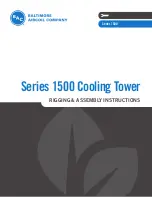
52
PRE-START-UP
Proceed as follows to inspect and prepare the unit for initial
start-up:
1. Remove all access panels.
2. Read and follow instructions on all WARNING, CAU-
TION, and INFORMATION labels attached to, or shipped
with, unit.
3. Make the following inspections:
a. Inspect for shipping and handling damages such as
broken lines, loose parts, or disconnected wires, etc.
b. Inspect for oil at all refrigerant tubing connections
and on unit base. Detecting oil generally indicates a
refrigerant leak. Leak-test all refrigerant tubing con-
nections using electronic leak detector, halide torch,
or liquid-soap solution.
c. Inspect all field-wiring and factory-wiring connec-
tions. Be sure that connections are completed and
tight. Be sure that wires are not in contact with refrig-
erant tubing or sharp edges.
d. Inspect coil fins. If damaged during shipping and han-
dling, carefully straighten fins with a fin comb.
4. Verify the following conditions:
a. Make sure that condenser-fan blade are correctly posi-
tioned in fan orifice. See Condenser-Fan Adjustment
section on page 17 for more details.
b. Make sure that air filter(s) are in place.
c. Make sure that condensate drain trap is filled with
water to ensure proper drainage.
d. Make sure that all tools and miscellaneous loose parts
have been removed.
START-UP, GENERAL
Unit Preparation
Make sure that unit has been installed in accordance with in-
stallation instructions and applicable codes.
Return-Air Filters
Make sure correct filters are installed in unit (see “APPENDIX
B — Physical Data” on page 57). Do not operate unit without
return-air filters.
Outdoor-Air Inlet Screens
Outdoor-air inlet screen must be in place before operating unit.
Compressor Mounting
Compressors are internally-spring mounted. Do not loosen or
remove compressor hold down bolts.
Internal Wiring
Check all electrical connections in unit control boxes. Tighten
as required.
Refrigerant Service Ports
Each unit system has two
1
/
4
-in. SAE flare (with check valves)
service ports: one on the suction line, and one on the compres-
sor discharge line. Be sure that caps on the ports are tight.
Compressor Rotation
On 3-phase units with scroll compressors, it is important to be cer-
tain compressor is rotating in the proper direction. To determine
whether or not compressor is rotating in the proper direction:
1. Connect service gages to suction and discharge pressure
fittings.
2. Energize the compressor.
3. The suction pressure should drop and the discharge pres-
sure should rise, as is normal on any start-up.
If the suction pressure does not drop and the discharge pressure
does not rise to normal levels:
1. Note that the evaporator fan is probably also rotating in
the wrong direction.
2. Turn off power to the unit and install lockout tag.
3. Reverse any two of the unit power leads.
4. Re-energize to the compressor. Check pressures.
The suction and discharge pressure levels should now move to
their normal start-up levels.
NOTE: When the compressor is rotating in the wrong direction,
the unit will make an elevated level of noise and will not provide
cooling.
Cooling
Set space thermostat to OFF position. To start unit, turn on
main power supply. Set system selector switch at COOL posi-
tion and fan switch at AUTO. position. Adjust thermostat to a
setting below room temperature. Compressor starts on closure
of contactor.
Check unit charge. Refer to Refrigerant Charge section.
Reset thermostat at a position above room temperature. Com-
pressor will shut off. Evaporator fan will shut off after a
30 second delay.
TO SHUT OFF UNIT
Set system selector switch at OFF position. Resetting thermo-
stat at a position above room temperature shuts unit off tempo-
rarily until space temperature exceeds thermostat setting.
Heating
To start unit, turn on main power supply.
WARNING
PERSONAL INJURY HAZARD
Failure to follow this warning could result in personal injury
or death.
1. Follow recognized safety practices and wear protec-
tive goggles when checking or servicing refrigerant
system.
2. Do not operate compressor or provide any electric
power to unit unless compressor terminal cover is in
place and secured.
3. Do not remove compressor terminal cover until all
electrical sources are disconnected.
4. Relieve all pressure from system before touching or
disturbing anything inside terminal box if refrigerant
leak is suspected around compressor terminals.
5. Never attempt to repair soldered connection while
refrigerant system is under pressure.
6. Do not use torch to remove any component. System
contains oil and refrigerant under pressure.
To remove a component, wear protective goggles and
proceed as follows:
a. Shut off electrical power to unit.
b. Recover refrigerant to relieve all pressure from
system using both high-pressure and low pressure
ports.
c. Cut component connection tubing with tubing
cutter and remove component from unit.
d. Carefully unsweat remaining tubing stubs when
necessary. Oil can ignite when exposed to torch
flame.
Содержание Puron R-410A
Страница 29: ...29 Fig 44 RTU Open Overlay for Economizer Wiring ...
Страница 30: ...30 Fig 45 VFD Overlay for W2770 Controller Wiring ...
Страница 50: ...50 Fig 63 50KC Typical Unit Wiring Diagram Power 06A 208 230 3 60 ...
Страница 51: ...51 Fig 64 50KC Unit Wiring Diagram Control A06 ...
Страница 76: ...76 Fig B Unit Wiring Diagram Controls for Sizes A04 A06 208 230 1 60 208 230 3 60 460 3 60 575 3 60 ...
Страница 77: ...77 Fig C Unit Wiring Diagram Power for Sizes A04 and A06 208 230 1 60 ...
Страница 78: ...78 Fig D Unit Wiring Diagram Power for Size A05 208 230 1 60 ...
Страница 79: ...79 Fig E Unit Wiring Diagram Power for Sizes A04 A06 208 230 3 60 460 3 60 575 3 60 ...
Страница 80: ...80 APPENDIX F MOTORMASTER SENSOR LOCATIONS Fig F 50KC A04 Outdoor Circuiting Fig G 50KC A05 Outdoor Circuiting ...
Страница 81: ...81 Fig H 50KC A06 Outdoor Circuiting ...
















































